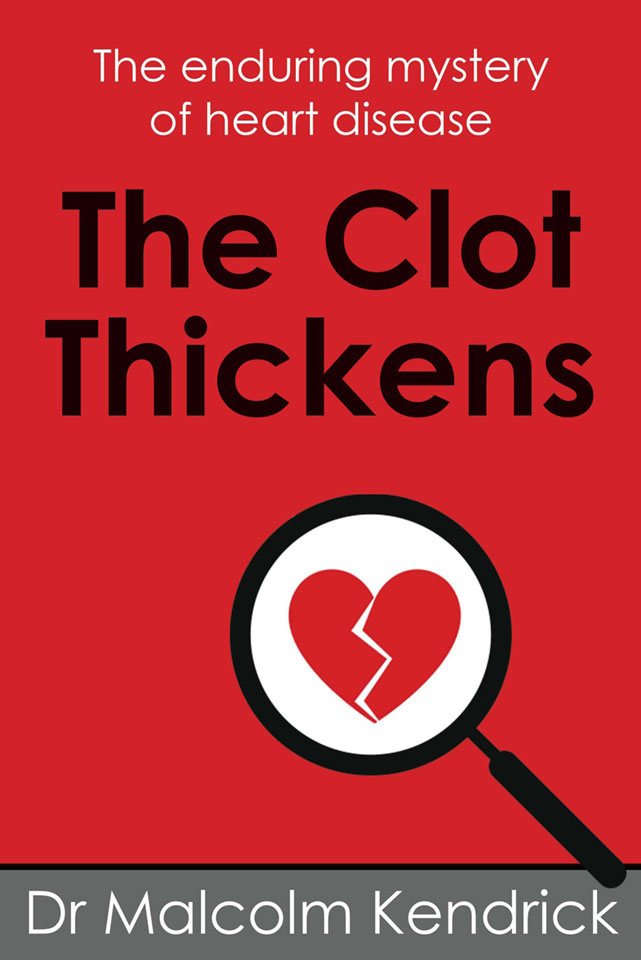The Clot Thickens, excerpt #1: The thrombogenic process – the players
Get The Clot Thickens, by Dr Malcom Kendrick @AMAZON.
Real science is never settled, and anyone who has certainty on such things is not qualified to discuss it.
There are numerous fascinating analyses in Dr Kendrick’s book. I will post more as time allows.
What causes atherosclerosis? We are all led to believe it is LDL cholesterol. Which is surely the biggest farce in the history of the world. The scientific support for a causal relationship between LDL and atherosclerosis has zero credible scientific basis. It is pure dogman, and actually quite ridiculous to the point of impossibility if the evidence is studied.
* One visit only to that assembly-line medicine charlatan.

The Clot Thickens, Chapter 3: The thrombogenic process – the players
Emphasis added.
.At this point I need to introduce you more formally to the key players in the game:
- The arteries and atherosclerosis
- The endothelium – endothelial cells
- The glycocalyx
- The blood clot/thrombus
- Endothelial progenitor cells
- Nitric oxide
I shall try to explain the role they all play in plaque formation, and plaque growth/rupture. This, you will be glad to hear, is the super-simplified version...
...Atherosclerosis only, naturally, develops in the large to mid-size arteries in the body. It never, ever, naturally, develops in the veins. Despite veins being exposed to exactly the same level of LDL as the arteries – thought I would just pop that in.
...It’s important to draw this distinction, because it is exceptionally rare for atherosclerosis to develop in any blood vessel in the lungs. Neither the arteries, nor the veins, no matter what size...
Yes, it is possible to get plaques in a vein, but only if you artificially turn a vein into an artery. An example of this is when you use a vein to create a coronary artery bypass graft (CABG). During this operation a section of vein is stripped out of the leg, then stitched onto a coronary artery either side of the blockage to bypass it. Vein grafts can then rapidly jam up with atherosclerosis.
Moving back to arteries, they have three main sections (and so do veins, although vein walls are much thinner):
- Externa
- Media
- Endothelium (sometimes called intima)
- The externa
...Which means that, at the very smallest ‘micro’ level, blood vessels become leaky. One of the reasons for mentioning this is because the vasa vasorum are also leaky, as they must be. Which means that LDL can move in and out of arterioles and capillaries, and straight into the artery wall – and also any vein wall.
This, in turn, means that the endothelium, lining the artery, is not actually a barrier to LDL at all. Any LDL that wishes to enter the artery wall, can simply get in through the back door – using the vasa vasorum. Think upon that, dear reader. And whilst you’re thinking on that, think on the fact that large veins have more vasa vasorum than arteries. Then ask yourself why LDL does not build up in veins to create plaques. Then see if you can come up with an answer to that question. Because I never could.
...
The glycocalyx
Here is something which I would roughly estimate that 99.8% of doctors have never heard of. Which is quite frankly amazing. My very accurate estimate is based on asking ten doctors if they had ever heard of it, and they all said no. Actually, they didn’t say no, because doctors hate to admit they don’t know something, including me**. But none of them could explain what it was.
The glycocalyx is the thing that makes many fish slippery, very slippery indeed. It is a layer of proteins and sugars (glycoproteins) which looks like a miniature meadow under a microscope. It is the super Teflon of the natural world (Figure 10).
Our endothelial cells are also covered (on one side) by this amazing and complicated layer that protects the endothelium from damage. It also contains a whole series of enzymes and other chemicals. Perhaps the most important of these molecules are powerful anti-coagulants (things that prevent blood clotting), such as: tissue factor inhibitor, antithrombin, protein C and nitric oxide (NO). So, not only is the glycocalyx ‘non-stick’ it actively resists the formation of blood clots. Below is a more complete list of its functions.
...The presence of the glycocalyx is another of the reasons why, when people tell me that LDL can leak past the endothelium and into the vessel wall behind, I just look at them as I would a young and innocent child, who has as yet learned little, and wonder if they have any idea of how ridiculous that sounds.
Do they even remotely understand the enormous complexity of the endothelial barrier, tight junctions, ion channels and suchlike? Have they ever heard of the glycocalyx that lines all endothelial cells? No, is pretty much the answer to all that.
Just to focus briefly on one item on that list above, where it states that the glycocalyx … “acts as a barrier against leakage of fluid, proteins and lipids across the vascular wall.” (For lipid read LDL).
The truth is that if you have a healthy glycocalyx, then you have a major protective barrier against endothelial damage, and also the formation of blood clots, and therefore CVD.
...I feel the need to add that the enormous complexity of the endothelium, and the very existence of the glycocalyx, was completely unknown when people were coming up with the cholesterol hypothesis.
‘Here is my theory about heart disease. Unfortunately, I know the square root of bugger all about the cardiovascular system, but I am sure it is true anyway.’ — A. N. Idiot.
...
WIND: wonderful book in raising fundamental questions that show just how fundamentally flawed the cholesterol hypothesis is, so flawed that no thinking person could take it seriously.



